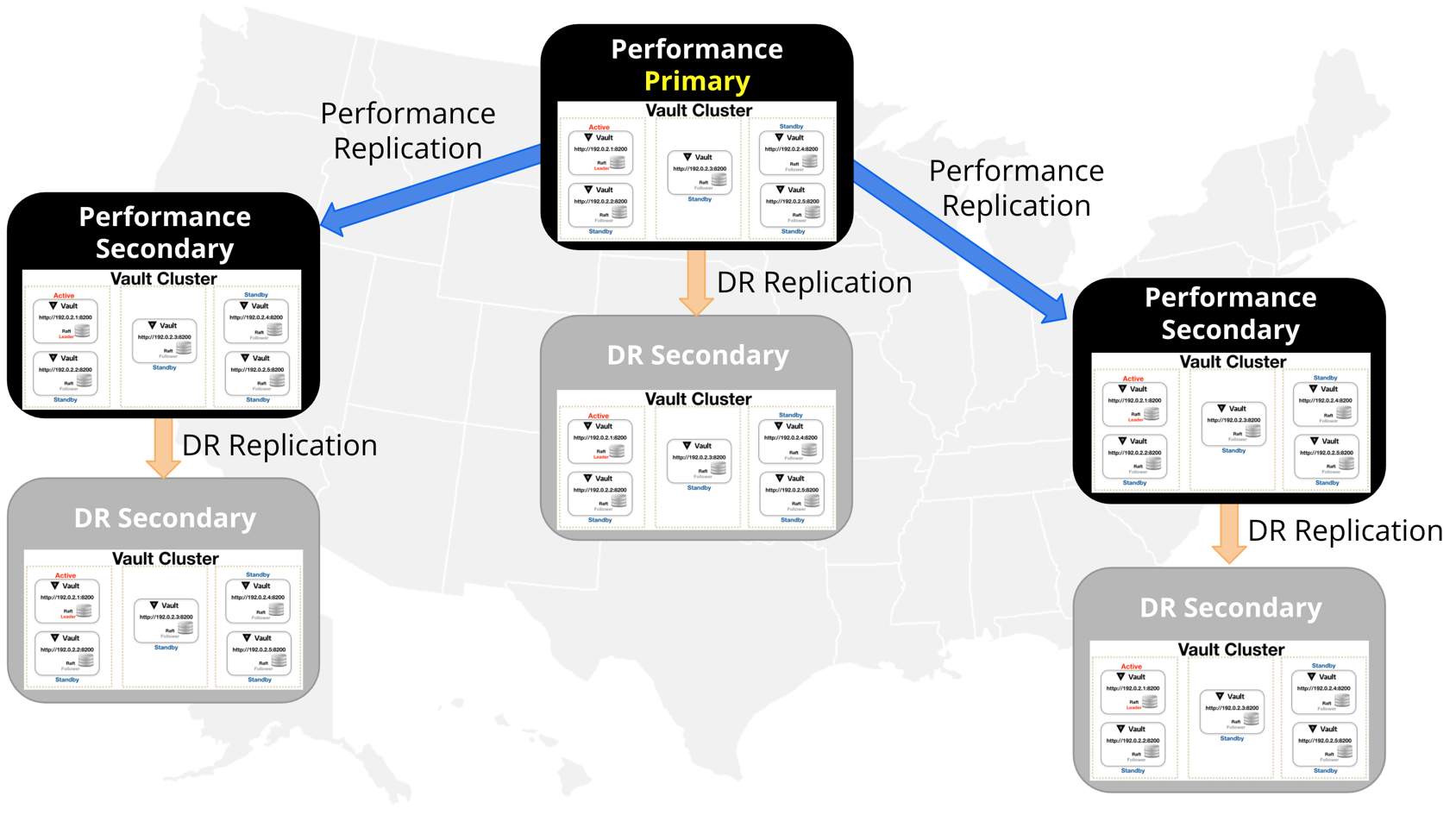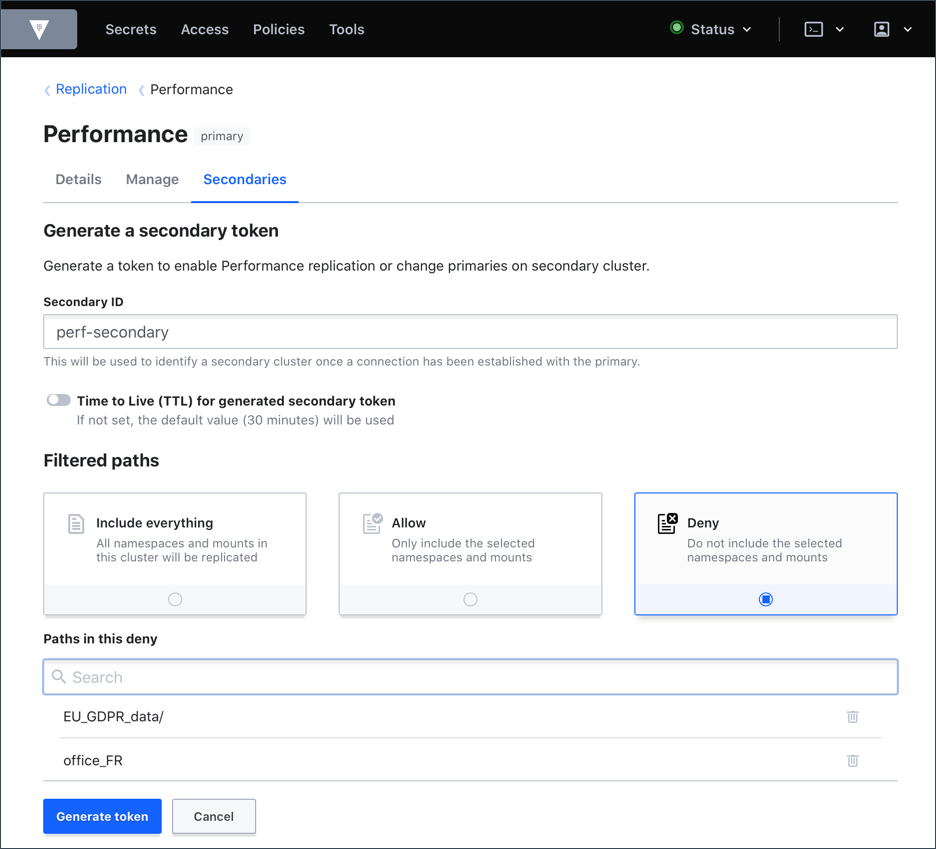Vault Enterprise replication
Overview
Many organizations have infrastructure that spans multiple datacenters. Vault provides the critical services of identity management, secrets storage, and policy management. This functionality is expected to be highly available and to scale as the number of clients and their functional needs increase; at the same time, operators would like to ensure that a common set of policies are enforced globally, and a consistent set of secrets and keys are exposed to applications that need to interoperate.
Vault replication addresses both of these needs in providing consistency, scalability, and highly-available disaster recovery.
Note: Using replication requires a storage backend that supports transactional updates, such as Integrated Storage or Consul.
Architecture
The core unit of Vault replication is a cluster, which is comprised of a collection of Vault nodes (an active and its corresponding HA nodes). Multiple Vault clusters communicate in a one-to-many near real-time flow.
Replication operates on a leader/follower model, wherein a leader cluster (known as a primary) is linked to a series of follower secondary clusters. The primary cluster acts as the system of record and asynchronously replicates most Vault data.
All communication between primaries and secondaries is end-to-end encrypted with mutually-authenticated TLS sessions, setup via replication tokens which are exchanged during bootstrapping.
Replicated data
What data is replicated between the primary and secondary depends on the type of replication that is configured between the primary and secondary. These types of relationships are either disaster recovery or performance replication relationships.

The following table shows a capability comparison between Disaster Recovery and Performance Replication.
| Capability | Disaster Recovery | Performance Replication |
|---|---|---|
| Mirrors the configuration of a primary cluster | Yes | Yes |
| Mirrors the configuration of a primary cluster’s backends (i.e., auth methods, secrets engines, audit devices, etc.) | Yes | Yes |
| Mirrors the tokens and leases for applications and users interacting with the primary cluster | Yes | No. Secondaries keep track of their own tokens and leases. When the secondary is promoted, applications must reauthenticate and obtain new leases from the newly-promoted primary. |
| Allows the secondary cluster to handle client requests | No | Yes |
Everything written to storage is classified into one of three categories:
replicated(or "shared"): all downstream clusters receive itlocal: only downstream disaster recovery clusters receive itignored: not replicated to downstream clusters at all
When mounting a secret engine or auth method, you can choose whether to make it a local mount or a shared mount.
Shared mounts (the default) usually replicate all their data to performance secondaries, but they can choose to designate specific storage paths as local. For example, PKI mounts store certificates locally. If you query the roles on a shared PKI mount, you'll see the same result for that mount when you send the query to either the performance primary or secondary, but if you list stored certs, you'll see different values.
Local mounts replicate their data only to disaster recovery secondaries. A local mount created on a performance primary isn't visible at all to its performance secondaries. Local mounts can also be created on performance secondaries, in which case they aren't visible to the performance primary.
There exist other storage entries that aren't mount specific. For example, the Integrated
Storage Autopilot configuration is an ignored storage entry, which allows for disaster recovery
secondaries to have a different configuration than their primary. Tokens and leases are written to
local storage entries.
Performance replication
Vault Enterprise license or HCP Vault Plus cluster required
In Performance Replication, secondaries keep track of their own tokens and leases
but share the underlying configuration, policies, and supporting secrets (K/V values,
encryption keys for transit, etc).
If a user action would modify underlying shared state, the secondary forwards the request
to the primary to be handled; this is transparent to the client. In practice, most
high-volume workloads (reads in the kv backend, encryption/decryption operations
in transit, etc.) can be satisfied by the local secondary, allowing Vault to scale
relatively horizontally with the number of secondaries rather than vertically as
in the past.
Paths filter
The primary cluster's mount configuration gets replicated across its secondary clusters when you enable Performance Replication. In some cases, you may not want all data to be replicated. For example, your primary cluster is in the EU region, and you have a secondary cluster outside of the EU region. General Data Protection Regulation (GDPR) requires that personally identifiable data not be physically transferred to locations outside the European Union unless the region or country has an equal rigor of data protection regulation as the EU.
To comply with GDPR, leverage Vault's paths filter feature to abide by data movements and sovereignty regulations while ensuring performance access across geographically distributed regions.
You can set filters based on the mount path of the secrets engines and namespaces.

In the above example, the EU_GDPR_data/ path and office_FR namespace will
not be replicated and remain only on the primary cluster.
On a similar note, if you want to avoid secondary cluster's data to be replicated, you can mark those secrets engine and/or auth methods local. Local secrets engines and auth methods are not replicated or removed by replication.
Example: When you enable a secrets engine on a secondary cluster, use the
-local flag.
Learn: Refer to the Performance Replication with Paths Filter tutorial for step-by-step instructions.
Disaster recovery (DR) replication
In disaster recovery (or DR) replication, secondaries share the same underlying configuration,
policy, and supporting secrets (K/V values, encryption keys for transit, etc) infrastructure
as the primary. They also share the same token and lease infrastructure as the primary, as
they are designed to allow for continuous operations with applications connecting to the
original primary on the election of the DR secondary.
DR is designed to be a mechanism to protect against catastrophic failure of entire clusters. They do not forward service read or write requests until they are elected and become a new primary.
Note: Unlike with Performance Replication, local secret engines, auth methods and audit devices are replicated to a DR secondary.
For more information on the capabilities of performance and disaster recovery replication, see the Vault Replication API Documentation.
Primary and secondary cluster compatibility
Storage engines
There is no requirement that both clusters use the same storage engine.
Seals
There is no requirement that both clusters use the same seal type, but see sealwrap for the full details.
Also note that enabling replication will modify the secondary seal. If the secondary uses an auto seal, its recovery configuration and keys will be replaced; if it uses shamir, its seal configuration and unseal keys will be replaced. Here seal/recovery configuration means the number of seal/recovery key fragments and the required threshold of those fragments.
| Primary Seal | Secondary Seal (before) | Secondary Seal (after) | Secondary Recovery Key (after) | Impact on Secondary of Enabling Replication |
|---|---|---|---|---|
| Shamir | Shamir | Primary's shamir config & unseal keys | N/A | Seal config and unseal keys replaced with primary's |
| Shamir | Auto | Unchanged | Receives primary seal | Seal recovery config and keys replaced with primary's seal config and keys |
| Auto | Auto | Unchanged | Receives primary recovery | Seal recovery config and recovery keys replaced with primary's |
| Auto | Shamir | Receives primary recovery | N/A | Seal config and keys replaced with primary's recovery seal config and keys |
Note: Clusters with Shamir seal config do not have separate recovery keys. Auto includes HSM, Cloud KMS, and Transit auto-unseal.
Vault versions
Vault changes are designed and tested to ensure that the upgrade instructions are viable, i.e. that a secondary can run a newer Vault version than its primary.
That said, we do not recommend running replicated Vault clusters with different versions any longer than necessary to perform the upgrade.
Internals
Details on the internal design of the replication feature can be found in the replication internals document.
Security model
Vault is trusted all over the world to keep secrets safe. As such, we have put extreme focus to detail to our replication model as well.
Primary/Secondary communication
When a cluster is marked as the primary it generates a self-signed CA certificate. On request, and given a user-specified identifier, the primary uses this CA certificate to generate a private key and certificate and packages these, along with some other information, into a replication bootstrapping bundle, a.k.a. a secondary activation token. The certificate is used to perform TLS mutual authentication between the primary and that secondary.
This CA certificate is never shared with secondaries, and no secondary ever has access to any other secondary’s certificate. In practice this means that revoking a secondary’s access to the primary does not allow it continue replication with any other machine; it also means that if a primary goes down, there is full administrative control over which cluster becomes primary. An attacker cannot spoof a secondary into believing that a cluster the attacker controls is the new primary without also being able to administratively direct the secondary to connect by giving it a new bootstrap package (which is an ACL-protected call).
Vault makes use of Application Layer Protocol Negotiation on its cluster port. This allows the same port to handle both request forwarding and replication, even while keeping the certificate root of trust and feature set different.
Secondary activation tokens
A secondary activation token is an extremely sensitive item and as such is protected via response wrapping. Experienced Vault users will note that the wrapping format for replication bootstrap packages is different from normal response wrapping tokens: it is a signed JWT. This allows the replication token to carry the redirect address of the primary cluster as part of the token. In most cases this means that simply providing the token to a new secondary is enough to activate replication, although this can also be overridden when the token is provided to the secondary.
Secondary activation tokens should be treated like Vault root tokens. If disclosed to a bad actor, that actor can gain access to all Vault data. It should therefore be treated with utmost sensitivity. Like all response-wrapping tokens, once the token is used successfully (in this case, to activate a secondary) it is useless, so it is only necessary to safeguard it from one machine to the next. Like with root tokens, HashiCorp recommends that when a secondary activation token is live, there are multiple eyes on it from generation until it is used.
Once a secondary is activated, its cluster information is stored safely behind its encrypted barrier.
Mutual TLS and load balancers
Vault generates its own certificates for cluster members. All replication traffic uses the cluster port using these Vault-generated certificates after initial bootstrapping. Because of this, the cluster traffic can NOT be terminated at the cluster port at a load balancer level.
Tutorial
Refer to the following tutorials replication setup and best practices:
- Setting up Performance Replication
- Disaster Recovery Replication Setup
- Performance Replication with Paths Filters
- Monitoring Vault Replication
API
The Vault replication component has a full HTTP API. Please see the Vault Replication API for more details.